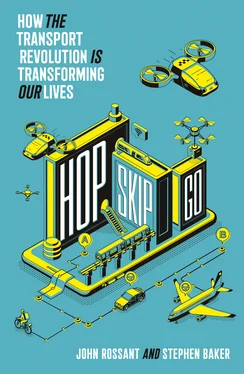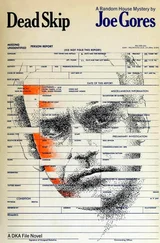Like Reynolds, Phil Washington, CEO of LA Metro, sees public transportation serving as the main trunks and branches of the third LA, with the scooters, bikes, and car-shares working as connecting tendrils. His logic is based on the immense distance to be traveled—all those round-trips to the sun. Millions of people, he says, must share a good portion of those miles. Otherwise, if each trip carries a single person on a single trajectory, the next stage of transit could be knotted up even worse than rush hour on the 405 at Sepulveda Pass.
From Washington’s point of view, the competition between public transit and all the mobility entrepreneurs just isn’t fair. LA County’s Metro, like other public agencies, has a mission to provide service to everyone. This dramatically raises costs. In the United States, for example, the Americans with Disabilities Act of 1990 mandates universal access to public transit. Metro must spend for buses that hoist wheelchairs from the curb, and equip train stations with ramps and elevators. It must also provide transport to isolated neighborhoods, and look out for those lacking a smartphone to hail an Uber. This is expensive. It serves the people who need help—whom mobility entrepreneurs can blithely ignore. Those new players, Reynolds says, “are building businesses on our infrastructure. And we get nothing in return.”
What’s worse is that if new privately owned services take off willy-nilly, each one rushing to develop its own niche, they’ll claw for market share by selling mobility at bargain-basement prices. A century ago, when this happened, the government was ineffectual. It ended up being an enabler of the automobile monoculture. Those cars also had the right, at least for their first century, to pollute, congest, and roar. Running over people was collateral damage.
Like most city officials, Reynolds is eager to avoid a reprise of that mess. She wants not just to supervise traffic, but to manage it. This isn’t easy, because broader LA County is fractured into scores of fairly independent municipalities. And Metro, like most transit agencies in the United States, is not particularly popular. Most motorists use it rarely (while wishing others would).
Yet in Los Angeles, as in cities worldwide, someone, some entity, is going to be monitoring and managing our movements. This will happen more in some places than in others. But this control is the nature, and the promise, of connected mobility, the key to cleaner, safer, cheaper, and faster movement. The political fights ahead will focus not just on the extent of this control, but also on who’s in charge. Governments are sure to jostle with businesses large and small, and the crucial factor will be data.
In coming years, practically every conveyance will be linked to networks. Most already are. But in Los Angeles, as we’ll see in Helsinki, the data travel in different streams. The subway counts its riders, as do dockless bike companies like Lime. The phone companies can track the movements of their users, as can Google and Facebook. When autonomous cars hit the roads in growing numbers, each one will gush thick rivers of data.
Yet at this point, no one has access to the entire span of mobility data. This is perhaps the ultimate treasure in the coming era. Whoever controls the data will be in a position to manage movement, and to build businesses on it. LA took a first step in 2019, establishing data specifications for bike-share and scooter services. This will allow officials to track their coverage, and coordinate with public transit. This common data standard is now dubbed MDS, for mobility datasets.
The key to controlling networked mobility is data. But who will own it? Could one dominant player, perhaps a company like Google, become the de facto mobility platform?
The strategy in the LA government is for the city to control the data, and to share it with other players on a need-to-know basis. From Reynolds’s point of view, who else can claim to be looking out for everyone?
Transit officials in LA have in fact been working on optimizing traffic for decades. Take an elevator down four levels beneath city hall, pass through a series of security barriers, and you’ll find yourself facing walls of TV screens in the Automated Traffic Surveillance and Control Room. Set up for the 1984 Olympics and originally funded by the federal government, it provides video feeds on hundreds of intersections and problem spots in LA. Back in 1984, the data analysis was primitive: human beings looked at TVs and saw traffic jams. The tools they had to respond were also unrefined. They could lengthen red or green lights where they saw problems, or in serious cases dispatch a traffic cop to the scene.
In the modern version, the surveillance network has spread to 4,700 intersections. In addition to images, sensors send in detailed reports on the traffic conditions: the number of vehicles passing, their speed, the flow of pedestrians. An AI engine churns through this information and attempts to optimize the flow, with a priority for mass transit. If a Metro bus, for example, is running behind schedule through East Hollywood, the computers can automatically orchestrate the lights on North Vermont Avenue to hurry it along.
Over time, the system will attempt to orchestrate the movement of growing numbers of vehicles, public and private alike. Autonomous cars, for example, will be sent along the most efficient paths and rerouted at a moment’s notice. Traffic lights will flash routing instructions to other cars, as well as to cyclists, and even to pedestrians.
When it comes to surveillance and control, as we’ll see in Dubai and Shanghai, this is still kids’ stuff. But unlike those cities, where government control has long been a fact of life, LA is attempting to manage millions of people who associate driving with freedom, who often view government with suspicion, if not contempt—and who can rebel at the polls against officials who rub them the wrong way.
ON THE BUSY pedestrian walkway in the oceanside municipality of Santa Monica, a black electric scooter, a Bird, is leaned against a palm tree. The Bird company, a hometown start-up, launched its business one autumn night simply by littering hundreds of its scooters throughout the eight square miles of Santa Monica, from its Ferris-wheeled pier all the way to the Brentwood town line. Residents who stopped the next morning to inspect these two-wheeled apparitions noticed a link to a smartphone app. Many downloaded the Bird app that very morning and started activating the scooters with their phones. (As a condition in the rental agreement, they vowed to wear bicycle helmets, but residents broke that promise en masse.) Paying a dollar for each ride, plus fifteen cents a minute, they were zipping around town with very few questions asked, other than “Will it get me there?” The answer was a resounding yes.
The day after the Bird scooters descended on Santa Monica, the company’s founder, a round-faced young man named Travis VanderZanden, reached out on LinkedIn to the mayor of Santa Monica, Ted Winterer, according to an account in the Washington Post . He invited him to drop by Bird’s headquarters. It was just a few blocks away. There they could discuss Bird’s mobility strategy for the region.
First, the mayor told him, they had a few legal issues to discuss. After all, Bird had never asked for authorization, much less discussed safety issues, sidewalks, or parking with the city. The company hadn’t said boo.
It didn’t take long to recognize a familiar pattern. VanderZanden, it turned out, was a former executive at both of the ride-sharing powerhouses, Lyft, and more significantly, Uber. The practice at Uber was to launch the service first and hammer out the legal details later. This had an impeccable logic. Once a mobility start-up gained lots of riders, it could attract millions of dollars from venture funders. Then it could use that money to hire armies of lawyers and make peace with the cities—to get legal. The key was to come to these negotiations as a popular and newly rich powerhouse, and not a supplicant.
Читать дальше












